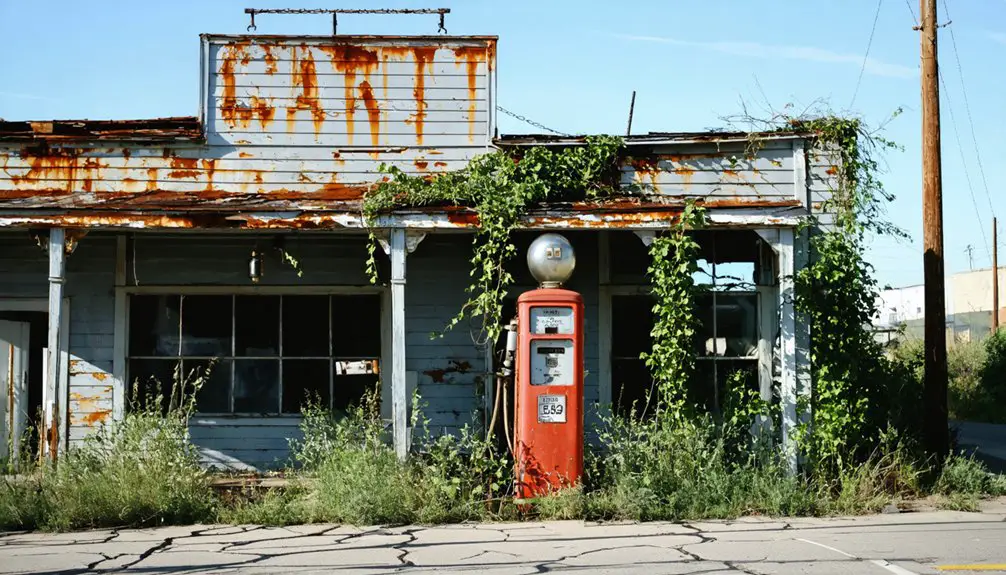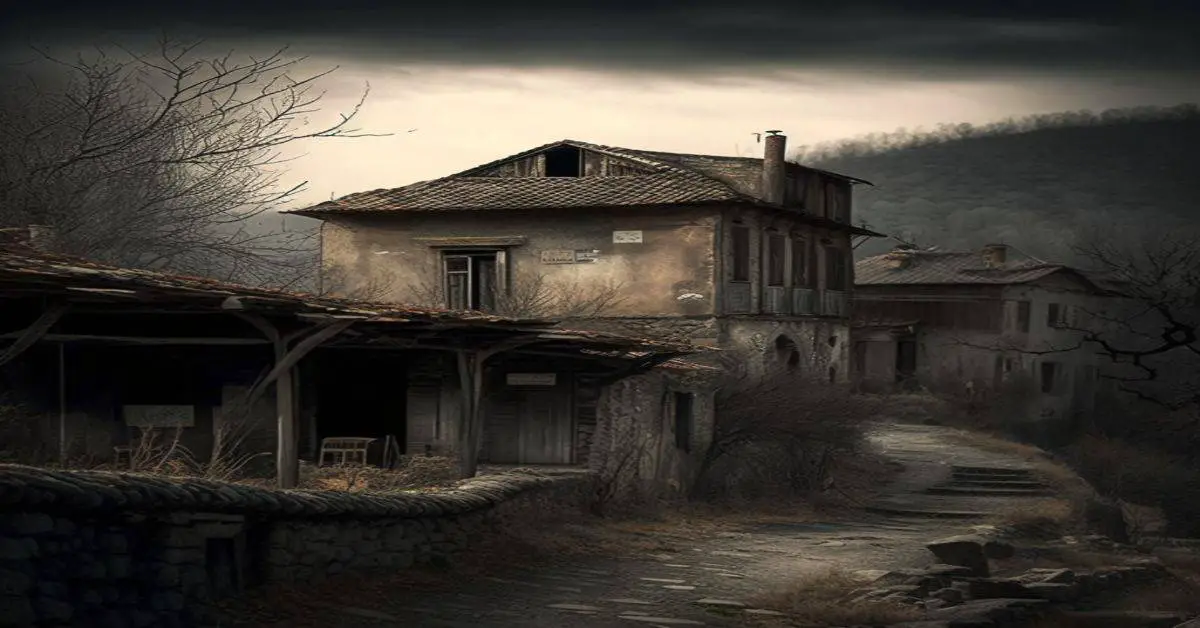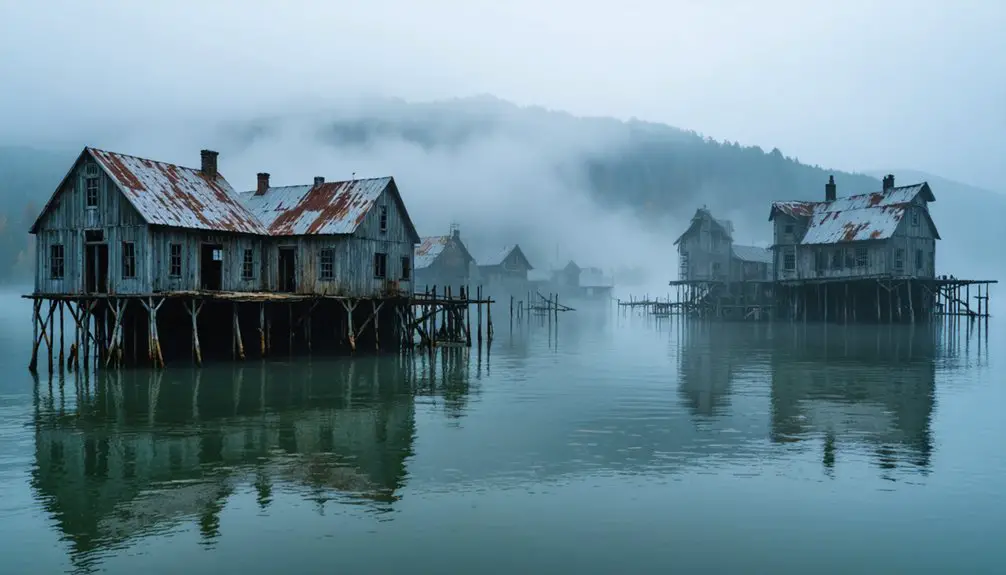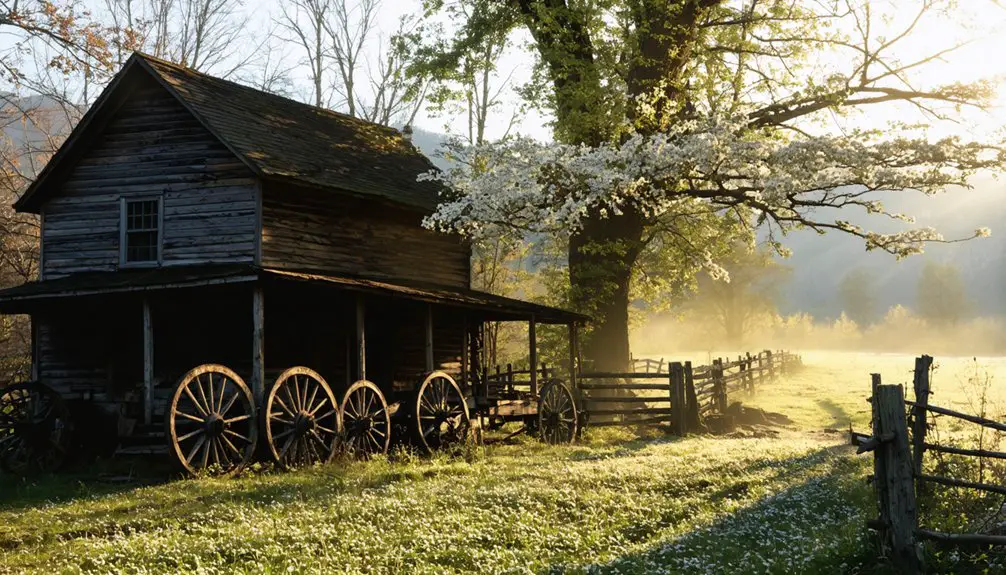You’ll find Jefferson’s haunting remains beneath Percy Priest Lake, where this former Rutherford County seat once thrived in the early 1800s. The town served as a bustling political center near the Stones River until 1813, when Murfreesboro claimed the county seat. Before its submersion in 1967, Jefferson played a vital role in the Trail of Tears and hosted notable figures like Andrew Jackson. The town’s underwater ruins and ghostly legends still captivate visitors seeking Tennessee’s lost history.
Key Takeaways
- Jefferson was Tennessee’s first political center in 1805 but declined within a decade after losing its county seat status to Murfreesboro.
- The town’s decline accelerated due to drying springs, shifting trade routes, and population changes by 1813.
- Percy Priest Lake’s construction in 1967 submerged much of Old Jefferson, transforming it into a ghost town.
- Historic structures were demolished during the Civil Rights era, leaving only remnants of the once-thriving political hub.
- The ghost town features reportedly haunted locations including Glenmore Mansion and Jefferson City Inn with unexplained phenomena.
Early Settlement and Rise as County Seat
When Governor William Blount established Jefferson County in 1792 as part of North Carolina’s territory, he set in motion a series of events that would shape the region’s early development.
Settlement patterns centered around the convergence of the Holston and French Broad rivers, where North Carolinians and Virginians had begun settling as early as 1783.
Early settlers from North Carolina and Virginia established communities where the Holston and French Broad rivers met.
You’ll find that judicial influences played a vital role in the area’s growth, with the first County Court organizing at Jeremiah Mathews’ home in July 1792.
The town of Jefferson emerged as a significant judicial hub when it was designated as the seat of justice in 1805.
The presence of courts attracted legal professionals and merchants, transforming this riverside settlement into a bustling center of commerce and law, though its prominence would prove temporary.
A brick courthouse was built between 1804 and 1806, measuring 40 feet by 40 feet and costing up to $3,000.
The Circuit Court’s organization in 1810 further strengthened the town’s status as a legal powerhouse.
The Lost Capital of Rutherford County
Jefferson’s rapid rise as Rutherford County’s first political center exemplified Tennessee’s early frontier development, with the town serving as a bustling hub for local government and river commerce.
Established in 1805, the town quickly grew to include a brick courthouse and jail, becoming an important destination for prominent legal figures.
Notable legal minds like Thomas H. Benton practiced law in Jefferson before moving on to distinguished political careers.
You’ll find that Jefferson’s tenure as county seat proved brief, lasting only until population shifts and economic changes favored a more central location.
The town’s political power transferred to Murfreesborough in the early 1800s, marking the beginning of Jefferson’s gradual decline from prominence to obscurity.
Early Political Hub Rise
In the early nineteenth century, the strategic placement of Jefferson at the forks of Stone’s River helped establish it as Rutherford County’s first political center.
The town’s civic foundation took shape in 1804 when county leaders designated it as the seat of government, moving administrative functions from temporary locations to this promising riverside settlement. Robert Weakley and Bedford surveyed and established the original town layout.
You’ll find Jefferson’s political significance reflected in its early development, where a courthouse anchored the town’s administrative core.
Notable legal minds, including future U.S. Senator Thomas H. Benton, cut their teeth in Jefferson’s courts.
The town’s position near Native American trails and its access to water routes made it an ideal choice for the region’s governing hub, while surrounding plantations and farms supported its growing importance as a center of commerce and justice.
However, the town’s prominence was short-lived when Murfreesboro in 1811 became the new county seat.
Short-Lived County Leadership
Despite its promising start as Rutherford County’s first political center, the town of Jefferson held its position as county seat for less than a decade.
You’ll find that after its 1805 establishment, Jefferson quickly attracted prominent legal minds, with future president Andrew Jackson and noted attorneys Felix Grundy and Thomas Hart Benton arguing cases in its courthouse.
But by 1813, economic decline had taken its toll. The drying springs of Stone’s River, shifting trade routes, and changing population patterns led the General Assembly to move the county seat to the more centrally located Murfreesboro.
Social tensions would later contribute to Jefferson’s ultimate downfall, with many historic structures destroyed during the Civil Rights era.
Today, only scattered remnants, including the relocated jail and Sam Davis Home, remind you of Jefferson’s brief political prominence.
Power Shifts to Murfreesborough
When Murfreesboro replaced Jefferson as Rutherford County’s seat in 1813, you could witness the dramatic transformation of a small settlement into Tennessee’s state capital by 1818. Through political maneuvering by influential citizens, the town quickly established itself as a regional powerhouse, growing from 950 to over 3,000 residents during its capital years.
Initially named Cannonsburgh in 1811, the town would soon become a pivotal center of Tennessee politics. You’d have seen remarkable economic expansion around the public square, with 20 saloons and 4 hotels catering to legislators, petitioners, and political figures like Davy Crockett.
The courthouse, jail, and other civic structures created a robust administrative center, while the bustling legislative sessions attracted diverse crowds. The first county courthouse completed in 1813 became a symbol of the town’s growing importance. This growth solidified Murfreesboro’s dominance over Jefferson and surrounding towns, establishing its role as the region’s commercial and transportation hub.
Life Along the Stones River
You’ll find extensive evidence of early trading posts along the Stones River where settlers like Owen Edwards and Thomas Nelson established riverside commerce in animal skins and tallow during the late 1700s.
The homesteads that sprang up featured distinctive two-story log structures with stone chimneys, positioned strategically on natural terraces above the flood plain to take advantage of river access while protecting against seasonal flooding. The area was originally known as Fish Creek before being renamed after explorer Uriah Stone. Andrew Jackson’s general store became a prominent business hub where settlers traded goods near the fertile Clover Bottoms region.
A bustling wharf district emerged where flatboats and keelboats transported goods downstream to New Orleans via the Cumberland River, creating a crucial economic lifeline for Jefferson’s early residents.
Early River Trading Posts
Along the banks of Tennessee’s Stones River, Old Jefferson emerged as an essential early 1800s river port settlement that connected frontier communities through expansive water-based commerce.
You’d find bustling trading posts where Native Americans bartered furs with European settlers, while flatboats and keelboats carried goods downstream to Nashville’s markets.
French traders first established posts in the region’s hunting grounds, creating critical economic links that would last nearly a century.
The river commerce flourished as settlers transported cedar logs, which were fundamental for making posts, buckets, and decorative home features.
These trading posts served as more than just economic hubs – they were cultural bridges between Native tribes like the Cherokee, Creek, Chickasaw, and Shawnee and the European settlers who’d eventually call this land home.
Riverside Homestead Architecture
The architectural legacy of Old Jefferson’s riverside homesteads stands as a tribute to the prosperity brought by the trading posts.
You’ll find stunning examples of this heritage in the circa 1831 Riverside Farm house, which blends late Victorian influences with Greek Revival elements. The two-story I-house showcases the region’s finest craftsmanship, featuring a classical front portico with towering columns and shouldered brick chimneys.
Inside, you’ll discover original woodwork and 1890s floral wallpaper that tell the story of changing tastes through the decades.
Behind the main house, a hand-hewn log dogtrot cabin represents the area’s earlier building traditions. The property’s strategic location along Stones River shaped its development, while its brick-making facilities once supplied materials for the community’s growth before being repurposed during the Civil War.
Flourishing Wharf District
Situated at the confluence of the Stones River’s east and west forks, Jefferson’s bustling wharf district emerged as Rutherford County’s commercial lifeline after its establishment in 1804.
You’d find the district humming with river trade as flatbed boats carried agricultural and forest products downstream to Nashville and New Orleans, a journey that could take up to 27 days when water levels cooperated.
The wharf district became a melting pot of cultural exchange, where trappers, traders, and settlers converged near the public square and courthouse.
While the Stones River’s unpredictable flooding challenged daily operations, the district functioned like an interstate highway of its time, connecting goods and traders from Philadelphia and Pittsburgh to southern markets – until modern roads and flood control measures ultimately led to its demise.
Trail of Tears Connection
During the tragic Cherokee removal of 1838, several detachments comprising around 4,000 men, women, and children followed an alternate Trail of Tears route through Old Jefferson, Tennessee. This path bypassed Murfreesboro’s costly toll gates, instead winding northwest along the East Fork of the Stones River through Jefferson’s bustling settlement.
Today, you’ll find segments of this historic Cherokee migration route preserved as part of the Twin Forks Horse Trail on Corps of Engineers property near Smyrna. While some believed Percy Priest Lake destroyed all evidence, modern mapping has revealed surviving trail sections.
The National Park Service now recognizes this important historical preservation site, where you can walk the same ground where Cherokee families once traveled, forced from their ancestral homes during one of America’s darkest chapters.
The Percy Priest Lake Project
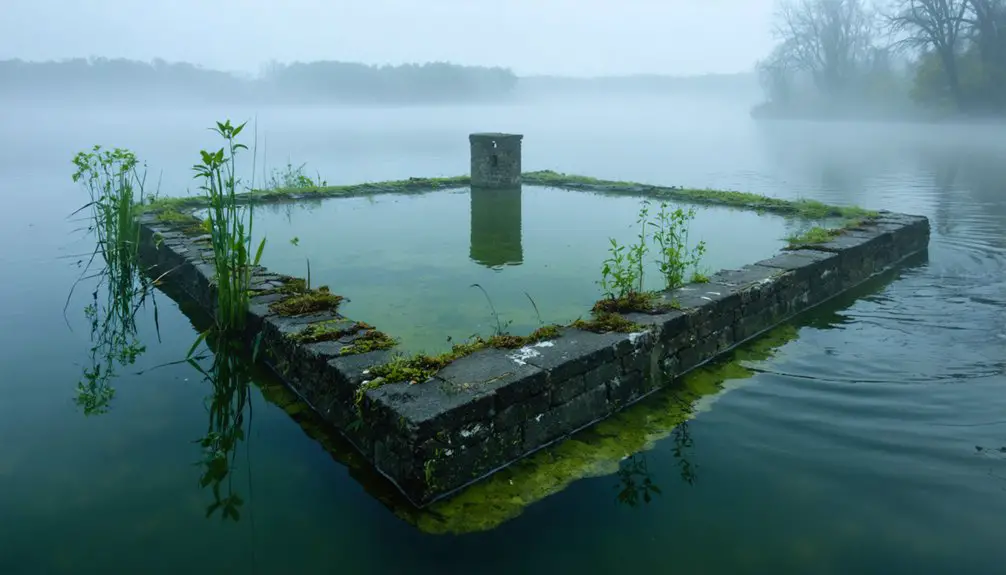
While the Trail of Tears route through Jefferson now rests beneath water, this submersion came from an ambitious post-war infrastructure project that transformed the region.
In 1946, Congress authorized what you’d initially know as the Stewarts Ferry Reservoir, later renamed Percy Priest Lake to honor a Tennessee congressman. Construction began in 1963, with the U.S. Army Corps of Engineers completing the project in 1967 at a cost of $57.36 million.
The massive undertaking created a 14,200-acre lake primarily for flood control in Nashville’s downstream areas.
You’ll find the dam about 10 miles east of downtown Nashville, its waters stretching 42 miles along what was once the Stones River. The project submerged several communities, including Jefferson, forever changing the landscape while creating new opportunities for water management and recreation.
The Town That Never Flooded
Despite being slated for submersion beneath Percy Priest Lake, Jefferson’s story took an ironic turn when the flooding never actually reached the abandoned town.
You’ll find it hard to believe, but residents were forced to relocate and their homes were burned down in preparation for waters that never came. The 1963 TVA project had convinced everyone that Jefferson would soon disappear beneath the reservoir’s surface.
What’s left today is a ghost town that stands as a monument to misplaced planning.
The once-bustling community, which thrived on crucial transportation routes and river commerce, was needlessly evacuated.
While the town had already declined due to shifting travel patterns, it’s the anticipation of flooding, rather than actual water, that dealt Jefferson its final blow.
Haunted Tales and Local Legends

A rich tapestry of haunted tales surrounds Jefferson’s abandoned streets and historic buildings, with the Glenmore Mansion standing as the epicenter of paranormal activity.
You’ll find unexplained lights dancing in the mansion’s attic, while a misty female figure drifts through its lower floors.
The nearby Jefferson City Inn harbors its own dark history, where ghostly encounters include a woman’s screams echoing down the stairs and mysterious gunshot sounds piercing the night.
Even Jefferson County High School can’t escape the supernatural, with students reporting an eternally cold closet and inexplicable scratch marks.
The school’s haunted legacy lives on through its mysterious cold spot and unexplained claw marks that defy rational explanation.
These spectral sightings, deeply rooted in Civil War history and local tragedy, have become part of the region’s identity.
Today, you can explore these haunted locations through paranormal tours, where centuries of spirits still linger in Tennessee’s misty hollows.
What Remains Today
Today you’ll find scattered remnants of Old Jefferson hidden beneath decades of forest growth, with only foundation stones and deteriorating roadbeds marking where this once-thriving town stood.
A partially collapsed cellar with descending stairs remains one of the most notable archaeological findings, while stone walls peek through the vegetation across the protected landscape.
You can explore these historic ruins within land now managed by the Army Corps of Engineers, though you’ll need to navigate hiking trails or forestry roads to reach the site.
While no formal tourist facilities exist, local historians occasionally lead educational tours.
The area’s environmental preservation status has helped protect these fragments of history, as limestone caves beneath the surface continue to regulate water flow just as they did when the town stood intact.
Legacy of a Vanished Community
Old Jefferson’s enduring influence stretches far beyond its physical remains, weaving through Tennessee’s cultural fabric as both a symbol of early pioneer life and a sobering reminder of progress’s costs.
You’ll find its community heritage preserved in local stories, from the Ephraim-Walter family histories to tales of the Trail of Tears that passed through the settlement.
The town’s cultural memory lives on through ghost stories and unexplained phenomena, drawing paranormal enthusiasts and historians alike.
While the Army Corps of Engineers may have razed the buildings for Percy Priest Lake, they couldn’t erase the deep connections residents formed with the land.
Today, the surprising survival of the unflooded townsite stands as a reflection of nature’s unpredictability and the lasting impact of displaced communities.
Frequently Asked Questions
What Happened to the Original Courthouse Records After Jefferson Lost County Seat Status?
You’ll find courthouse preservation efforts guaranteed the historical documentation remained under Jefferson County officials, who either transferred records to the new county seat or preserved them in designated archives with some microfilmed copies.
Were Any Artifacts or Valuables Recovered During the Town’s Demolition?
You’ll find scattered artifacts like rusty cans, broken bottles, and face cream jars were recovered, but their historical preservation significance remains limited since residents intentionally burned most valuables before the demolition.
How Many Families Were Displaced When the Town Was Demolished?
Like scattered seeds in the wind, you’ll find no exact count of displaced families from the town demolition, though historical records suggest multiple generations of homesteaders were uprooted by the forced relocation.
Did Any Businesses From Old Jefferson Relocate to Nearby Communities?
You’ll find that businesses did relocate, with many moving to Murfreesboro, which had become the regional hub. Local history shows commercial activities shifted to nearby communities along established transportation routes.
What Was the Population of Jefferson at Its Peak?
You’ll find the peak population reached just over 100 residents in 1810, with historical significance as a small county seat. Records show it didn’t grow much beyond that before declining.
References
- https://www.onlyinyourstate.com/trip-ideas/tennessee/abandoned-rutherford-tn
- https://visitjeffersoncountytn.com/scary-tales-of-jefferson-county-tn/
- https://www.tnmagazine.org/19-ghost-towns-in-tennessee-that-are-not-underwater/
- https://www.gatlinburgghostwalks.com/gatlinburg-ghost-stories/jefferson-city-ghosts.html
- https://www.tnvacation.com/articles/ghost-towns-tennessee
- https://rutherfordtnhistory.org/a-history-of-the-town-of-jefferson/
- https://jeffersoncountytn.gov/230th-celebration/
- https://jefferson.tngenealogy.net/about-jefferson-county/44-history/86-historical-background-malone?showall=1
- https://tennesseeencyclopedia.net/entries/jefferson-county/
- https://jeffersoncountytennessee.com/dandridge-history-county-seat-named-first-first-lady/
